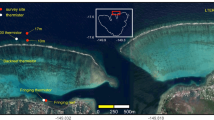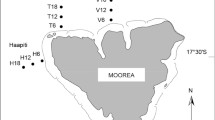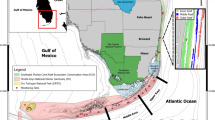Abstract
Most tropical coral reefs are experiencing declining coral cover, yet interpretation of this generality is tempered by spatial variation in coral cover among reefs separated over 20–200 km. This study addresses such landscape scale variation in coral reefs at 12 sites (7–10 m depth) around St. John (18° 18´ 37.04 N, 63° 43´ 23.17 W) and St. Thomas (18° 20´ 43.57 N, 65° 55´ 13.88 W), US Virgin Islands. Surveys completed from 2011 to 2021 were used to test for spatial variation in community dynamics among islands, shores, and sites. Community synchrony (φ) was used to evaluate portfolio effects in mediating changes in coral communities. From 2011 to 2021, changes in benthic communities differed among sites and times (i.e., there were site × year interactions), and, while coral cover declined at 11 sites, the decline was 2.6-fold faster around St. Thomas than St. John. The loss of coral cover was driven by multiple taxa that differed among sites, thus revealing asynchronous responses to prevailing conditions. Asynchrony suggests that coral communities at some of the sites have the capacity to exploit portfolio effects to modulate stability, yet these effects did not prevent declines in coral cover that reflect island-scale phenomena. In the US Virgin Islands, coral death is overwhelming the capacity for resilience of coral communities that historically may have benefitted from portfolio effects. Until coral assemblages are depleted through taxonomic extirpation, maintenance of the assemblage composition retains the possibility that increased resilience might emerge if environmental challenges can be alleviated.





Similar content being viewed by others
Data availability
The data for this project are hosted at http://www.bco-dmo.org/dataset/872285 and can be accessed using https://doi.org/10.26008/1912/bco-dmo.872285.1.
References
Abbott RE, Doak DF, Peterson ML (2017) Portfolio effects, climate change, and the persistence of small populations: analyses on the rare plant Saussurea weberi. Ecology 98:1071–1081
Allemand D, Tambutté É, Zoccola D, Tambutté S (2011) Coral calcification, cells to reefs. In: Dubinsky Z, Stambler N (eds) Coral reefs: an ecosystem in transition. Springer, Netherlands, Dordrecht, pp 119–150
Almany GR (2003) Priority effects in coral reef fish communities. Ecology 84:1920–1935
Aronson RB, Precht WF, Murdoch TJT, Robbart ML (2005) Long-term persistence of coral assemblages on the flower garden banks, northwestern Gulf of Mexico: implications for science and management. Gulf Mex Sci 1:84–94
Beger M, Selkoe KA, Treml E, Barber PH, Von Der Heyden S, Crandall ED, Toonen RJ, Riginos C (2014) Evolving coral reef conservation with genetic information. Bull Mar Sci 90:159–185. https://doi.org/10.5343/bms.2012.1106
Beijbom O, Edmunds PJ, Roelfsema C, Smith J, Kline DI, Neal BP, Dunlap MJ, Moriarty V, Fan T-Y, Tan C-J, Chan S, Treibitz T, Gamst A, Mitchell BG, Kriegman D (2015) Towards automated annotation of benthic survey images: variability of human experts and operational modes of automation. PLoS One 10:e0130312. https://doi.org/10.1371/journal.pone.0130312
Black K, Moran P, Hammond L (1991) Numerical models show coral reefs can be self-seeding. Mar Ecol Prog Ser 74:1–11
Brandt ME, Ennis RS, Meiling SS, Townsend J, Cobleigh K, Glahn A, Quetel J, Brandtneris V, Henderson LM, Smith TB (2021) The emergence and initial impact of stony coral tissue loss disease (SCTLD) in the United States Virgin Islands. Front Mar Sci 8:715329. https://doi.org/10.3389/fmars.2021.715329
Bruno JF, Selig ER (2007) Regional decline of coral cover in the Indo-Pacific: timing, extent, and subregional comparisons. PLoS One 2:e711–e711
Carpenter KE et al (2008) One-third of reef-building corals face elevated extinction risk from climate change and local impacts. Science 321:560–563
Chérubin LM, Garavelli L (2016) Eastern Caribbean circulation and island mass effect on St. Croix, US Virgin Islands: a mechanism for relatively consistent recruitment patterns. PLoS One 11:e0150409–e0150409
Cinner JE et al (2016) Bright spots among the world’s coral reefs. Nature 535:416–419
Clarke KR, Gorley RN (2006) Primer v6: user manual/tutorial. PRIMER-E Ltd., Plymouth, UK
Connell JH, Slatyer RO (1977) Mechanisms of succession in natural communities and their role in community stability and organization. Am Nat 111:1119–1144
Connell JH, Hughes TP, Wallace CC (1997) A 30-year study of coral abundance, recruitment, and disturbance at several scales in space and time. Ecol Monogr 67:461–488
Costa SV, Hibberts SJ, Olive DA, Budd KA, Long AE, Meiling SS, Miller MB, Vaugn KM, Carrion CI, Cohen MB, Savage AE, Souza MF, Buckley L, Grimes KW, Platenberg R, Smith TB, Blondeau J, Brandt ME (2021) Diversity and disease: the effects of coral diversity on prevalence and impacts of stony coral tissue loss disease in St. Thomas U.S. Virgin Islands. Front Mar Sci 8:682688. https://doi.org/10.3389/fmars.2021.682688
Cunning R, Gates RD, Edmunds PJ (2017) Using high-throughput sequencing of ITS2 to describe Symbiodinium metacommunities in St. John. US Virgin Islands PeerJ 2017:e3472–e3472
Eddy TD, Lam VWY, Reygondeau G, Cisneros-Montemayor AM, Greer K, Palomares MLD, Bruno JF, Ota Y, Cheung WWL (2021) Global decline in capacity of coral reefs to provide ecosystem services. One Earth 4:1278–1285. https://doi.org/10.1016/j.oneear.2021.08.016
Edmunds PJ (2013) Decadal-scale changes in the community structure of coral reefs of St. John, US Virgin Islands. Mar Ecol Prog Ser 489:107–123
Edmunds PJ (2014) Landscape-scale variation in coral reef community structure in the United States Virgin Islands. Mar Ecol Prog Ser 509:137–152
Edmunds PJ (2019) Three decades of degradation lead to diminished impacts of severe hurricanes on Caribbean reefs. Ecology 100:e02587
Edmunds PJ (2021) Recruitment hotspots and bottlenecks mediate the distribution of corals on a Caribbean reef. Biol Lett 17:20210149
Edmunds PJ, Bruno JF (1996) The importance of sampling scale in ecology: kilometer-wide variation in coral reef communities. Mar Ecol Prog Ser 143:165–171
Edmunds PJ, Tsounis G, Lasker HR (2015) Differential distribution of octocorals and scleractinians around St. John and St. Thomas, US Virgin Islands. Hydrobiologia 767:347–360
Ennis RS, Kadison K, Heidmann S, Henderson LM, Warham M, Smith TB (2020) The United States Virgin Islands territorial coral reef monitoring program. 2020 annual report. University of the Virgin Islands, United States Virgin Islands, p 293
Eyre BD, Cyronak T, Drupp P, Carlo EHD, Sachs JP, Andersson AJ (2018) Coral reefs will transition to net dissolving before end of century. Science 359:908–911
Figueiredo J, Baird AH, Connolly SR (2013) Synthesizing larval competence dynamics and reef-scale retention reveals a high potential for self-recruitment in corals. Ecology 94:650–659
Fukami T (2015) Historical contingency in community assembly: integrating niches, species pools, and priority effects. Ann Rev Ecol Evol Syst 46:1–23
Gallery DN, Green ML, Kuffner IB, Lenz EA, Toth LT (2021) Genetic structure and diversity of the mustard hill coral Porites astreoides along the Florida keys reef tract. Mar Biodivers 51:63. https://doi.org/10.1007/s12526-021-01196-7
Glassom D, Celliers L, Schleyer MH (2006) Coral recruitment patterns at Sodwana Bay, South Africa. Coral Reefs 25:485–492
Goreau TF (1959) The ecology of Jamaican coral reefs I. Species composition and zonation. Ecology 40:67–90
Graham NAJ, Jennings S, MacNeil MA, Mouillot D, Wilson SK (2015) Predicting climate-driven regime shifts versus rebound potential in coral reefs. Nature 518:94–97
Green RH (1993) Application of repeated measures designs in environmental impact and monitoring studies. Aust J Ecol 18:81–98
Guest JR, Edmunds PJ, Gates RD, Kuffner IB, Andersson AJ, Barnes BB, Chollett I, Courtney TA, Elahi R, Gross K, Lenz EA, Mitarai S, Mumby PJ, Nelson HR, Parker BA, Putnam HM, Rogers CS, Toth LT (2018) A framework for identifying and characterising coral reef “oases” against a backdrop of degradation. J Appl Ecol 55:2865–2875. https://doi.org/10.1111/1365-2664.13179
Hock K, Doropoulos C, Gorton R, Condie SA, Mumby PJ (2019) Split spawning increases robustness of coral larval supply and inter-reef connectivity. Nat Commun 10:3463. https://doi.org/10.1038/s41467-019-11367-7
Hoegh-Guldberg O, Mumby PJ, Hooten AJ, Steneck RS, Greenfield P, Gomez E, Harvell CD, Sale PF, Edwards AJ, Caldeira K, Knowlton N, Eakin CM, Iglesias-Prieto R, Muthiga N, Bradbury RH, Dubi A, Hatziolos ME (2007) Coral reefs under rapid climate change and ocean acidification. Science 318:1737–1742. https://doi.org/10.1126/science.1152509
Hoegh-Guldberg O, Kennedy EV, Beyer HL, McClennen C, Possingham HP (2018) Securing a long-term future for coral reefs. Trends Ecol Evol 33:936–944. https://doi.org/10.1016/j.tree.2018.09.006
Holbrook SJ, Adam TC, Edmunds PJ, Schmitt RJ, Carpenter RC, Brooks AJ, Lenihan HS, Briggs CJ (2018) Recruitment drives spatial variation in recovery rates of resilient coral reefs. Sci Rep 8:7338–7311
Holstein DM, Paris CB, Mumby PJ (2014) Consistency and inconsistency in multispecies population network dynamics of coral reef ecosystems. Mar Ecol Prog Ser 499:1–18
Horst G, Edmunds PJ (2010) Spatio-temporal variation in seawater characteristics in a semi-enclosed bay in St. John, U.S. Virgin Islands. Carib J Sci 46:54–63
Hughes TP et al (2019) Global warming impairs stock–recruitment dynamics of corals. Nature 568:387–390
Hull PM, Darroch SAF, Erwin DH (2015) Rarity in mass extinctions and the future of ecosystems. Nature 528:345–351
Jackson JBC (1991) Adaptation and diversity of reef corals. Bioscience 41:475–482
Jackson JBC, Donovan MK, Cramer KL, Lam VV (eds) (2014) Status and trends of Caribbean coral reefs: 1970–2012. Global coral reef monitoring network. IUCN, Gland
Karlson RH, Hurd LE (1993) Disturbance, coral reef communities, and changing ecological paradigms. Coral Reefs 12:117–125
Kool JT, Paris CB, Barber PH, Cowen RK (2011) Connectivity and the development of population genetic structure in Indo-West Pacific coral reef communities: Indo-West Pacific connectivity. Global Ecol Biogeogr 20:695–706
Kough AS, Paris CB (2015) The influence of spawning periodicity on population connectivity. Coral Reefs 34:753–757
Kumpf HE, Randall HA (1961) Charting the marine environments of St. John, U.S. Virgin Islands Bull Mar Sci 11:543–551
Leibold MA et al (2004) The metacommunity concept: a framework for multi-scale community ecology. Ecol Lett 7:601–613
Loreau M et al (2021) Biodiversity as insurance: from concept to measurement and application. Biol Rev Camb Philos Soc 96:2333–2354
Loya Y (1972) Community structure and species diversity of hermatypic corals at Eilat, Red Sea. Mar Biol 13:100–123
Marshall DJ, Monro K, Bode M, Keough MJ, Swearer S (2010) Phenotype–environment mismatches reduce connectivity in the sea. Ecol Lett 13:128–140
Mittelbach GG, Steiner CF, Scheiner SM, Gross KL, Reynolds HL, Waide RB, Willig MR, Dodson SI, Gough L (2001) What is the observed relationship between species richness and productivity? Ecology 82:2381–2396
Moritz C, Brandl SJ, Rouzé H, Vii J, Pérez-Rosales G, Bosserelle P, Chancerelle Y, Glazin R, Liao V, Siu G, Taiarui M, Nugues MM, Hédouin L (2021) Long-term monitoring of benthic communities reveals spatial determinants of disturbance and recovery dynamics on coral reefs. Mar Ecol Prog Ser 672:141–152. https://doi.org/10.3354/meps13807
Norström AV, Nyström M, Lokrantz J, Folke C (2009) Alternative states on coral reefs: beyond coral-macroalgal phase shifts. Mar Ecol Prog Ser 376:295–306
Oliver ECJ, Donat MG, Burows MT, Moore PJ, Smale DA, Alexander LV, Benthuysen JA, Gupta AS, Hobday AJ, Holbrook NJ, Perkins-Kirkpatrick SE, Scannell HA, Straub SC, Wernberg T (2018) Longer and more frequent marine heatwaves over the past century. Nat Commun 9:1324–1312
Pawlik JR, McMurray SE (2020) The emerging ecological and biogeochemical importance of sponges on coral reefs. Annu Rev Mar Sci 12:315–337. https://doi.org/10.1146/annurev-marine-010419-010807
Pearson R (1981) Recovery and recolonization of coral reefs. Mar Ecol Prog Ser 4:105–122
Richardson PL (2005) Caribbean current and eddies as observed by surface drifters. Deep Sea Res Part II Top Stud Oceanogr 52:429–463. https://doi.org/10.1016/j.dsr2.2004.11.001
Rogers CS (1993) Hurricanes and coral reefs-the intermediate disturbance hypothesis revisited. Coral Reefs 12:127–137
Rogers C (2009) Coral bleaching and disease should not be underestimated as causes of Caribbean coral reef decline. Proc R Soc Lond B 276:197–198
Rogers CS, Miller J, Muller EM, Edmunds P, Nemeth RS, Beets JP, Friedlander AM, Smith TB, Boulon R, Jeffrey CFG, Menza C, Caldow C, Idrisi N, Kojis B, Monaco ME, Spitzack A, Gladfelter EH, Ogden JC, Hillis-Starr Z, Lundgren I, Bane Schill W, Kuffner IB, Richardson LL, Devine BE, Voss JD (2008) Ecology of coral reefs in the US Virgin Islands. In: Riegl BM, Dodge RE (eds) Coral reefs of the USA, 1st edn. Springer, Dordrecht, pp 303–373
Schindler DE, Armstrong JB, Reed TE (2015) The portfolio concept in ecology and evolution. Front Ecol Environ 13:257–263. https://doi.org/10.1890/140275
Schutte VGW, Selig ER, Bruno JF (2010) Regional spatio-temporal trends in Caribbean coral reef benthic communities. Mar Ecol Prog Ser 402:115–122
Serrano XM, Baums IB, Smith TB, Jones RJ, Shearer TL, Baker AC (2016) Long distance dispersal and vertical gene flow in the Caribbean brooding coral Porites astreoides. Sci Rep 6:21619–21619
Shulman MJ, Ogden JC, Ebersole JP, McFarland WN, Miller SL, Wolf NG (1983) Priority effects in the recruitment of juvenile coral reef fishes. Ecology 64:1508–1513
Smith TB, Nemeth RS, Blondeau J, Calnan JM, Kadison E, Herzlieb S (2008) Assessing coral reef health across onshore to offshore stress gradients in the US Virgin Islands. Mar Pollut Bull 56:1983–1991
Steneck RS, Arnold SN, Boenish R, de León R, Mumby PJ, Rasher DB, Wilson MW (2019) Managing recovery resilience in coral reefs against climate-induced bleaching and hurricanes: A 15 year case study from Bonaire, Dutch Caribbean. Front Mar Sci 6:265. https://doi.org/10.3389/fmars.2019.00265
Stoddart DR (1963) Effects of Hurricane Hattie on the British Honduras reefs and cays, October 30–31, 1961. Atoll Res Bull 95:1–142
Stoddart DR (1969) Ecology and morphology of recent coral reefs. Biol Rev Camb Philos Soc 44:433–498
Sully S, Hodgson G, vanWoesik R (2022) Present and future bright and dark spots for coral reefs through climate change. Glob Change Biol. https://doi.org/10.1111/gcb.16083
Thibaut LM, Connolly SR (2013) Understanding diversity-stability relationships: towards a unified model of portfolio effects. Ecol Lett 16:140–150
Thomson DP, Frisch AJ (2010) Extraordinarily high coral cover on a nearshore, high-latitude reef in south-west Australia. Coral Reefs 29:923–927
Van der Meer J (1997) Sampling design of monitoring programmes for marine benthos: a comparison between the use of fixed versus randomly selected stations. J Sea Res 37:167–179. https://doi.org/10.1016/S1385-1101(97)00007-5
Veron JEN, Hoegh-Guldberg O, Lenton TM, Lough JM, Obura DO, Pearce-Kelly P, Sheppard CRC, Spalding M, Stafford-Smith MG, Rogers AD (2009) The coral reef crisis: the critical importance of <350 ppm CO2. Mar Pollut Bull 58:1428–1436. https://doi.org/10.1016/j.marpolbul.2009.09.009
Wood S, Paris CB, Ridgwell A, Hendy EJ (2014) Modeling dispersal and connectivity of broadcast spawning corals at the global scale. Global Ecol Biogeogr 23:1–11
Zar JH (2010) Biostatistical analysis. Pearson Prentice-Hall, Upper Saddle River
Acknowledgements
PJE thanks N. Bean, J. Girard, and E. Lenz for assistance with fieldwork, and V. Powell and S. Prosterman for logistical support in St. John. This is contribution number 368 of the CSUN marine biology program, and contribution number 245 from the Center for Marine and Environmental Studies, University of the Virgin Islands.
Funding
This research was funded by the US National Science Foundation (OCE 20–19992).
Author information
Authors and Affiliations
Contributions
PJE designed, implemented and analyzed the study and completed the first draft of the manuscript; PJE and TBS collaborated on interpreting the data, develo** the summary statements, and editing the final manuscript.
Corresponding author
Ethics declarations
Conflict of interest
The authors declare they have conflict of interests.
Human and animal rights
All applicable international, national, and/or institutional guidelines for the care and use of animals were followed (no animals were manipulated or sampled in this research). Research was completed under research permits issued through the Virgin Islands National Park (VIIS-2021_SCI-0001).
Additional information
Responsible Editor: C. Voolstra.
Publisher's Note
Springer Nature remains neutral with regard to jurisdictional claims in published maps and institutional affiliations.
Supplementary Information
Below is the link to the electronic supplementary material.
Rights and permissions
About this article
Cite this article
Edmunds, P.J., Smith, T.B. Spatial variation in the dynamics and synchrony of coral reef communities in the US Virgin Islands. Mar Biol 169, 60 (2022). https://doi.org/10.1007/s00227-022-04048-5
Received:
Accepted:
Published:
DOI: https://doi.org/10.1007/s00227-022-04048-5




